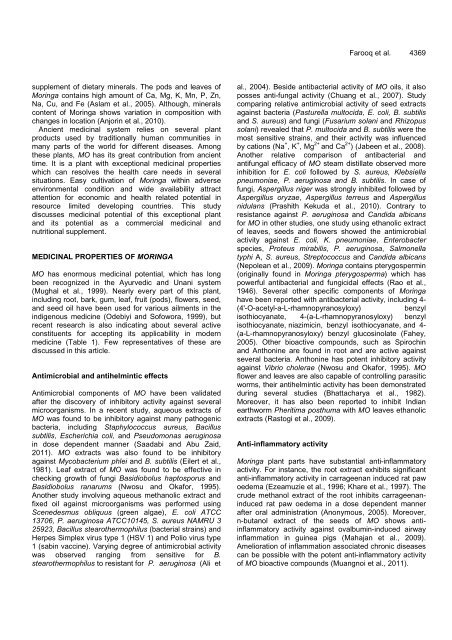Download Complete Issue (4740kb) - Academic Journals
Download Complete Issue (4740kb) - Academic Journals
Download Complete Issue (4740kb) - Academic Journals
Create successful ePaper yourself
Turn your PDF publications into a flip-book with our unique Google optimized e-Paper software.
supplement of dietary minerals. The pods and leaves of<br />
Moringa contains high amount of Ca, Mg, K, Mn, P, Zn,<br />
Na, Cu, and Fe (Aslam et al., 2005). Although, minerals<br />
content of Moringa shows variation in composition with<br />
changes in location (Anjorin et al., 2010).<br />
Ancient medicinal system relies on several plant<br />
products used by traditionally human communities in<br />
many parts of the world for different diseases. Among<br />
these plants, MO has its great contribution from ancient<br />
time. It is a plant with exceptional medicinal properties<br />
which can resolves the health care needs in several<br />
situations. Easy cultivation of Moringa within adverse<br />
environmental condition and wide availability attract<br />
attention for economic and health related potential in<br />
resource limited developing countries. This study<br />
discusses medicinal potential of this exceptional plant<br />
and its potential as a commercial medicinal and<br />
nutritional supplement.<br />
MEDICINAL PROPERTIES OF MORINGA<br />
MO has enormous medicinal potential, which has long<br />
been recognized in the Ayurvedic and Unani system<br />
(Mughal et al., 1999). Nearly every part of this plant,<br />
including root, bark, gum, leaf, fruit (pods), flowers, seed,<br />
and seed oil have been used for various ailments in the<br />
indigenous medicine (Odebiyi and Sofowora, 1999), but<br />
recent research is also indicating about several active<br />
constituents for accepting its applicability in modern<br />
medicine (Table 1). Few representatives of these are<br />
discussed in this article.<br />
Antimicrobial and antihelmintic effects<br />
Antimicrobial components of MO have been validated<br />
after the discovery of inhibitory activity against several<br />
microorganisms. In a recent study, aqueous extracts of<br />
MO was found to be inhibitory against many pathogenic<br />
bacteria, including Staphylococcus aureus, Bacillus<br />
subtilis, Escherichia coli, and Pseudomonas aeruginosa<br />
in dose dependent manner (Saadabi and Abu Zaid,<br />
2011). MO extracts was also found to be inhibitory<br />
against Mycobacterium phlei and B. subtilis (Eilert et al.,<br />
1981). Leaf extract of MO was found to be effective in<br />
checking growth of fungi Basidiobolus haptosporus and<br />
Basidiobolus ranarums (Nwosu and Okafor, 1995).<br />
Another study involving aqueous methanolic extract and<br />
fixed oil against microorganisms was performed using<br />
Scenedesmus obliquus (green algae), E. coli ATCC<br />
13706, P. aeruginosa ATCC10145, S. aureus NAMRU 3<br />
25923, Bacillus stearothermophilus (bacterial strains) and<br />
Herpes Simplex virus type 1 (HSV 1) and Polio virus type<br />
1 (sabin vaccine). Varying degree of antimicrobial activity<br />
was observed ranging from sensitive for B.<br />
stearothermophilus to resistant for P. aeruginosa (Ali et<br />
Farooq et al. 4369<br />
al., 2004). Beside antibacterial activity of MO oils, it also<br />
posses anti-fungal activity (Chuang et al., 2007). Study<br />
comparing relative antimicrobial activity of seed extracts<br />
against bacteria (Pasturella multocida, E. coli, B. subtilis<br />
and S. aureus) and fungi (Fusarium solani and Rhizopus<br />
solani) revealed that P. multocida and B. subtilis were the<br />
most sensitive strains, and their activity was influenced<br />
by cations (Na + , K + , Mg 2+ and Ca 2+ ) (Jabeen et al., 2008).<br />
Another relative comparison of antibacterial and<br />
antifungal efficacy of MO steam distillate observed more<br />
inhibition for E. coli followed by S. aureus, Klebsiella<br />
pneumoniae, P. aeruginosa and B. subtilis. In case of<br />
fungi, Aspergillus niger was strongly inhibited followed by<br />
Aspergillus oryzae, Aspergillus terreus and Aspergillus<br />
nidulans (Prashith Kekuda et al., 2010). Contrary to<br />
resistance against P. aeruginosa and Candida albicans<br />
for MO in other studies, one study using ethanolic extract<br />
of leaves, seeds and flowers showed the antimicrobial<br />
activity against E. coli, K. pneumoniae, Enterobacter<br />
species, Proteus mirabilis, P. aeruginosa, Salmonella<br />
typhi A, S. aureus, Streptococcus and Candida albicans<br />
(Nepolean et al., 2009). Moringa contains pterygospermin<br />
(originally found in Moringa pterygosperma) which has<br />
powerful antibacterial and fungicidal effects (Rao et al.,<br />
1946). Several other specific components of Moringa<br />
have been reported with antibacterial activity, including 4-<br />
(4'-O-acetyl-a-L-rhamnopyranosyloxy) benzyl<br />
isothiocyanate, 4-(a-L-rhamnopyranosyloxy) benzyl<br />
isothiocyanate, niazimicin, benzyl isothiocyanate, and 4-<br />
(a-L-rhamnopyranosyloxy) benzyl glucosinolate (Fahey,<br />
2005). Other bioactive compounds, such as Spirochin<br />
and Anthonine are found in root and are active against<br />
several bacteria. Anthonine has potent inhibitory activity<br />
against Vibrio cholerae (Nwosu and Okafor, 1995). MO<br />
flower and leaves are also capable of controlling parasitic<br />
worms, their antihelmintic activity has been demonstrated<br />
during several studies (Bhattacharya et al., 1982).<br />
Moreover, it has also been reported to inhibit Indian<br />
earthworm Pheritima posthuma with MO leaves ethanolic<br />
extracts (Rastogi et al., 2009).<br />
Anti-inflammatory activity<br />
Moringa plant parts have substantial anti-inflammatory<br />
activity. For instance, the root extract exhibits significant<br />
anti-inflammatory activity in carrageenan induced rat paw<br />
oedema (Ezeamuzie et al., 1996; Khare et al., 1997). The<br />
crude methanol extract of the root inhibits carrageenaninduced<br />
rat paw oedema in a dose dependent manner<br />
after oral administration (Anonymous, 2005). Moreover,<br />
n-butanol extract of the seeds of MO shows antiinflammatory<br />
activity against ovalbumin-induced airway<br />
inflammation in guinea pigs (Mahajan et al., 2009).<br />
Amelioration of inflammation associated chronic diseases<br />
can be possible with the potent anti-inflammatory activity<br />
of MO bioactive compounds (Muangnoi et al., 2011).

















